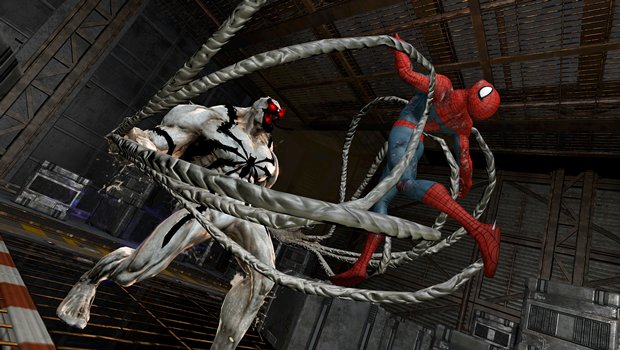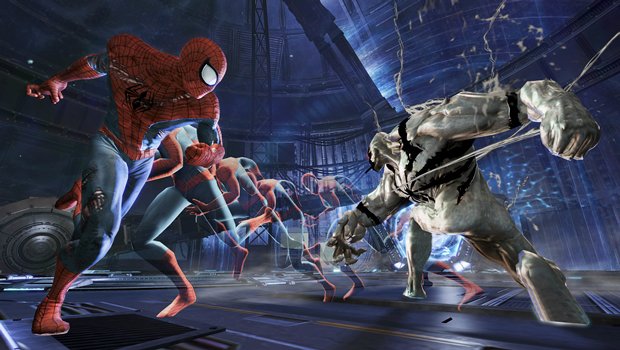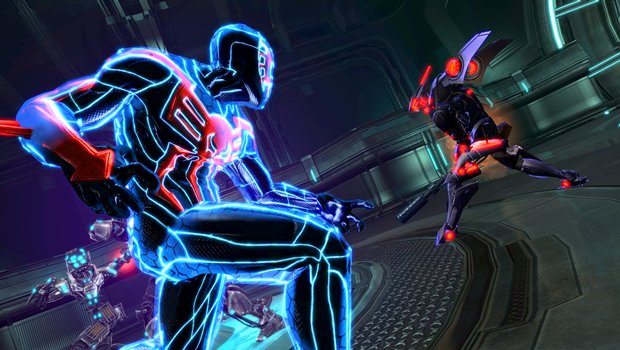Spider-Man - OLD
Spidey toys with time... and Anti-Venom
Wereally wanted to love Beenox’s last Spider-Man game, Shattered Dimensions. It was a cool idea to have four Spider-Men team up across four alternate universes in order to reset the rift Mysterio created in the Marvel dimensional continuum. The gameplay didn’t hold upquite aswell as we'd hoped, but that hasn’t stopped Beenox from retoolingthe conceptual idea again - sort of.

Think of Edge of Time as a corollary to Shattered Dimensions. Rather than screw with the dimensional continuity of the Spider-Man universe, Edge of Time deals with ruptures in the timelines of the Amazing Spiderman and Spidey 2099. The game’s script, written by 2099 co-creator Peter David, brings the two webheads together after an evil scientist from the 2099 universe sets forth a chain of events that ultimately leads to the death of Amazing Spidey. Naturally this won’t do at all, so 2099, or Miguel O’Hara as he’s known in civilian life, has to team up with Peter Parker across time in order to restore the proper timeline to the Spidey universe.
Unlike Shattered Dimensions, Edge of Time works on a rule of causality, so the actions of one Spider-Man can affect the world of the other. Essentially if you’ve ever played any game related to time travel, you’re probably aware of how the team-up process works: one Spider-Man has to move toward objective X until he is impeded by obstacle Y, at which point the roles are reversed, with the other Spidey taking action to affect change in the other Spider-Man’s timeline; the process then repeats itself.

Ourhands-off demo booted up starting in Amazing Spidey’s world, with O’Hara acting as his picture-in-picture guide in the corner of the screen. Parker and O’Hara are making their way through a massive biotech lab in their respective timelines (think Oscorp but on a much larger scale). Much like in Shattered Dimensions, the Spider-Men encounter plenty of thugs and henchman. The combat seems to be an improvement over the mostly-sameish combos of Beenox’s last Spidey effort, with Parker and O’Hara’s combat more focused on acrobatic web attacks and close-combat melee strikes, respectively. Amazing can also now use hyper-sense, an accelerated form of spider-sense which can be used to evade moves and speed through obstacles. O’Hara also has a special spidey move - he can essentially move faster than time, allowing him to create decoys to deceive and time vortexeswhich rip up enemies.
What makes Edge of Time more interesting than Shattered Dimensions is how the two timelines are reactive to each other. Pursuing Anti-Venom in present day, Amazing Spidey has to get away from a massive explosion inside the facility. While he is able to escape, the damage causes containment failure in multiple nuclear regulators in 2099’s time, forcing Amazing to fix them before O’Hara dies. Even more interesting is that when playing as 2099, the world is particularly reactive to changes in Parker’s time - there were a number of times through the demo that enemies would appear or disappear, and even whole landscapes might change while you’re fighting in them. It’s a cool effect in practice, although it’s unclear how much of this is just window dressing, given the game’s strict narrative focus.

The demo ended abruptly with a boss battle against Anti-Venom - while demo reps for the game said Spidey would gradually lose strength and power the more he was attacked, the fight didn’t go on long enough for any energy sapping to be apparent. It seems clear that Beenox has learned from some of the mistakes of Shattered Dimensions, and with its less splintered storyline and a more dynamic design, it could do ol’ Webhead proud. We’ll find out when the game hits this fall.
Jun 10, 2011
Weekly digests, tales from the communities you love, and more


